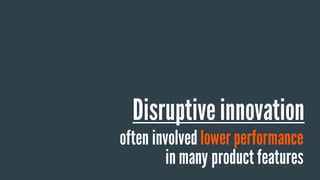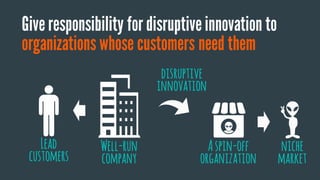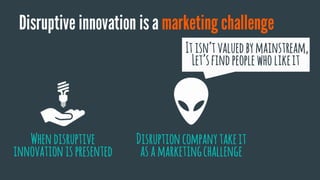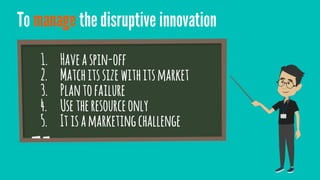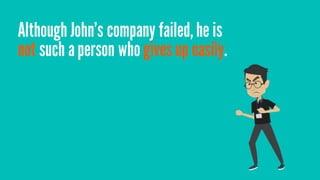The innovator's dilemma
- 1. The innovator’s dilemmaWhen New TechnologiesCause Great Firms to Fail
- 2. Clayton M.Christensen Professorof BusinessAdministration HarvardBusinessSchool About theAuthor: GlobalBusinessBook Award Thebest businessbook oftheyear (1997) The Innovator’sDilemma
- 3. Li Wei Technology commercialization manager Exploit Technologies PteLtd (ETPL) Agency for Science,Technology and Research (A*STAR, Singapore) Summary andpresentationby B. Eng&Ph.d (Engineering) Nanyang Technological University Singapore M.B.A. INSEAD Fontainebleau, France
- 4. This is John
- 6. John is a product engineer ina well established technology company
- 7. Hiscompany has been the leader in this market for decades
- 8. But one day ...
- 9. John’s company wentout of business, and he losthis job
- 10. In thepast one year,his company lost almost all their customers toacompetitor withadisruptive innovation
- 11. John is really sad because hiscompany didn’t do anything wrong,somehow, they lost the competitionso badly
- 12. But John doesn’t know that his company failed because THEYDIDEVERYTHINGRIGHT
- 13. To understand thereason, John must know twotypesof innovation Sustaining Innovation Disruptive InnovationVS
- 14. improves product’s performance based on the features valued by mainstream customers SustainingInnovation
- 15. It is aiming at moving upward along certain performance metrics Speed power
- 16. often involvedlower performance inmany product features Disruptiveinnovation
- 17. born inthe niche market that’s neglected by current market offering Itisfor nichemarket
- 18. Sustaining innovation is drivenby existing market demand But it can ultimately fail the company
- 19. Disruptive innovation is an unproven opportunity But it can be the future of the company
- 20. This is the core of the innovator’sdilemma
- 21. Why didJohn’s company, themarket leader, miss the opportunity for the disruptive innovation?
- 22. Let’s findout what happened to John’s company
- 23. John had many ideas for new products and improvements
- 24. With the marketing department, the project team gathered feedback from their lead customers and didthe market analysis
- 25. They chose the best project for the product or improvement their leader customers want Bigmarketsize Bestprofitmargin Customervalidation best project
- 27. Meanwhile, the competitor withdisruptive innovation …
- 28. Their product was not valued by main stream market,but they found a niche market by trial and error
- 29. As their product improving,the competitor managed to growtheniche market and encroach the customer base of John’s company
- 30. John’s company belatedly jumped on the bandwagon todefend customer base
- 31. However,inthe newly developed market, John’s company hadn’t developed any competitiveadvantage and they are too late
- 32. In thehistory, thesame story happened to many great companies
- 33. They failedbecause the very management practices that made them market leader also make itextremely difficultfor them to develop the disruptive innovation
- 34. To understand thedifficulties, weneed to firstly understand theconcept of Value Network
- 35. The context within whicha organization is established to get what itvalues Value Network revenuefrom Theleadcustomers Fora established company,thisisthe valuetheyareafter
- 36. The highest performing company hasa well-developed system tailoredtocapture thevalue fromitsleadcustomers Structure Capability Operation Culture Partnership Management Theleadcustomers Valuenetwork
- 37. Withina valuenetwork, the systemanditspast choices of markets,determines itsperceptions of the valueof aninnovation
- 38. It drives resource allocation towards sustaining innovation that isvalued by the current lead customers Funding Manpower
- 39. And, it isextremely difficultto keep resources fora disruptive innovation fora unproven market ? Funding Manpower
- 40. Thispatternof resource allocationaccountsfor the well-run companies’ leadershipinthe sustaininginnovationandtheir dismalperformance inthe disruptiveone sustaininginnovation disruptiveinnovation
- 41. If we can turn the time backwards, can John’s company do something different to better manage the disruptive innovation?
- 42. There are fiveprinciples of disruptive innovation
- 43. The managers can harness these principleto their advantage
- 44. 1Customers effectively control the patterns of resource allocation in well-runcompanies Lead customers Well-run company
- 45. Lead customers Well-run company Aspin-off organization niche market Giveresponsibility for disruptiveinnovation to organizations whose customers need them disruptive innovation
- 46. 2Small markets don’t solve the growthneeds of largecompanies Large company Largerandlarger andlarger
- 47. Place disruptiveinnovation projects inorganizations small enough toget excited about small market Small organization disruptive innovation Small market Thisis good enoughforme
- 48. 3Markets of disruptive innovation may not exist and can’t beanalyzed Dothesebeforeyou talktomeagain
- 49. Plan tofail early and inexpensively in thesearch for the market for disruptive innovation
- 50. 4The existing process and values define the organizations’ disabilities when confronted withdisruption
- 51. Utilizetheresources of themainstream organizationto address disruption, but not its processes and values Idon’tneedaoiltruck,but Ineedthepetrolinitstank
- 52. 5Technology supply may not equal market demand Itis notgood enough,Let’s improve its technology When disruptive innovation is presented Establishedfirms takeitas a technicalchallenge
- 53. Disruptive innovation isa marketing challenge When disruptive innovation is presented Disruption companytakeit as a marketingchallenge Itisn’tvaluedbymainstream, Let’sfindpeople who likeit
- 54. Hi,John. Couldyou please giveus a summary?
- 55. Hi,John. Couldyou please giveus a summary? OK!
- 56. Why great company can fail Thebusiness existsinavaluenetwork thatshapes leaders’decisions. It could blindthemtothe disruptiveinnovation andlosethefuture opportunity
- 57. To manage thedisruptive innovation 1. Haveaspin-off 2. Matchitssize withitsmarket 3. Plantofailure 4. Use theresourceonly 5. It isamarketingchallenge
- 58. Although John’s company failed,he is not such aperson whogivesup easily.
- 59. Hejoins a start-up witha disruptive innovation
- 60. In aniche market, they don’t need toworry too muchabout their larger competitors
- 61. This givesthem moretime tofinetune their technology and develop afuture mass market
- 62. Likemany other start-ups and entrepreneurs, they will surprise the much larger competitors indifference













